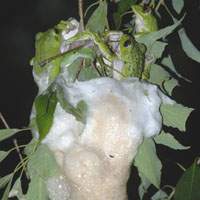* Japanese name: Moriao-gaeru
* Scientific name: Rhacophorus arboreus
* Description: A cute little, beautiful green frog; males are 4-6 cm long, females are 6-8 cm long. The backs can be mottled with brown speckles, and the number of these speckles varies according to where in the country they live. The fingers and toes have round suckers. The eyes are red but have a rainbow reflection.
* Where to find them: In Honshu, in forests, around rice fields, and in marshy land. They live in mountainous forests as high up as 2,000 meters. In the breeding season, the frogs can be found near ponds and lakes, but outside of this time they live in trees in forests. They are nocturnal and endemic to Japan. In the winter they hibernate in mud.
* Food: Insects and spiders. Their predators are snakes, weasels, foxes, racoon dogs and badgers.
* Special features: Mating takes place from April to July, which is quite a long breeding season for a frog. Males call from trees near water to attract females. Once they have paired up, the couple find a suitable branch and, kicking their legs, produce a mass of sticky foam some 10-15 cm long. Foam-making, mating and egg-laying takes 1 to 2 hours. Amazingly, between 300 and 500 eggs are laid in the foamy mass, and they develop there for a week, kept moist and safe above the water where they are safe from hungry fish. You can see trees covered in foam, from a distance looking like strange white-yellow flowers. The surface of the foam dries and forms a protective shell. This is the only frog in Japan that lays its eggs in trees. After a week, the eggs hatch and when it next rains, the tadpoles squirm through the foam and drop into the water below. With the inevitable loss of suitable habitat, frogs may lay their foam masses on buildings. This frog has been accorded "special natural monument" status in Japan, meaning that it is one of the animals considered essential for the understanding of Japanese natural history and culture -- it's a bit like the frog equivalent of cherry blossom.
PHOTO COURTESY OF BIO-IMAGE NET



